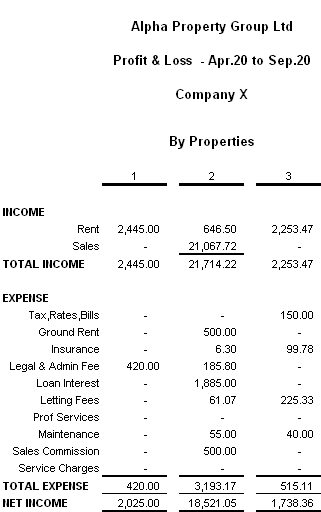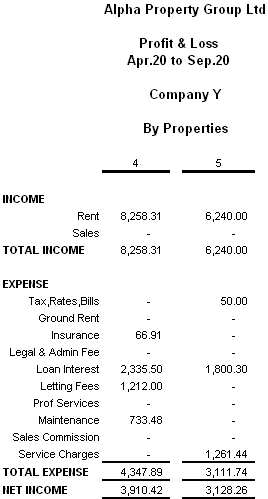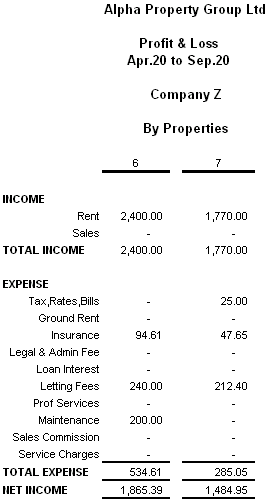Help
Group Property Company Profit and Loss Statements
Property investors may administer their property stock either directly themselves or via limited liability companies. In the latter case the company potentially limits the liability of the owner if any debts arise from investing in a property. For simplification we will restrict ourselves to property stock administered by limited liability companies. Such companies will be termed property companies.
Property companies can own one or more properties. Moreover these companies can be grouped together by their owners using a parent company that holds shares in its subsidary companies. Financial reporting for such company groups is called group company accounts.
To illusrate group company accounts we used a fictious property company group called The Alpha Group of Companies Ltd. The Alpha Group has three companies which are Company X, Company Y and Company Z
These companies have a total of six properties between them with another property in process of acquisition.
company X owns three properties which are property 1, property 2 and property 3
company Y has two properties which are property 4 and property 5
company Z has one property which is property 6 and is acquiring another which is property 7
The profit and loss group company accounts split by property.
The profit and loss statement is a breakdown of the income and expenses which each property generates for their respective companies in the financial period. In short it is an analysis of the profitability of the group company property stock. This will be illustrated by examining property stock by its operating profit (i.e. Net Operating Income ) and then by its net profit.
Group Company Operating Profit Analysis
Company X

Property 1 This property was originally built as a house and later bought by company X. It was then split into two appartments to generate rental income. Property valuation was done using the
Income (Investment) Method. To do this the directors of company X relied on Capitalisation Rate (Cap Rate). Based on this the building was purchased for $245,000 and then refurbished for $5,000 for a total cost of $250,000. It was estimated, on the basis of comparable properties, that the building would generate on Gross Potential Income (GPI) of $12,480 per annum. This works out to a total weekly rental income of $240 with the assumption that both appartments are fully occupied and that rents are always paid. That is, the Vacancy and Credit Loss is assumed to be $0. Though this was the case the actual annual rent collected or Gross Operating Income for this property was $11,440 which was $1,040 less than anticipated. This was because the weekly rent actually agreed was $220 instead of the original $240. The direct expenses incurred in operating the property is $7,720 of which $7,000 is spent on loan interest on the mortgage taken out on the property. Deducting $7,720 from $11,440 leaves a Net Operating Income of $3,720. This a comparatively low figure in relation to the other properties in company X's portfolio. Hence the directors of the company will review whether to retain this property for the next financial period.
Property 2This property was initially acquired by company X several years ago to lease out on the basis of a high projected Estimated Rental Value (ERV). However, the actual rent was significantly lower than anticipated so it was proposed to sell the property. Property valuation was done using the
Comparable Method and property was sold for a net sales income of $51,000. There was also a small rental income of $1,250 giving a total net sales income of $52,250. The direct expenses incurred in operating the property is $12,903 of which $7,500 is for sales commission and $4,200 is spent on mortgage loan interest. Deducting $12,903 from $52,250 leaves a Net Operating Income of $39,347. However, this will not be repeated for next financial period as property 2 is no longer part of company X's property stock.
Property 3
This property is a small grocery shop situated at the bottom of an apartment block along a busy shopping centre. The directors of company X acquired the property for $315,000 after valuing it using the Profit (Accounts) Method. Refurbishments were done for $5,000 to enhance the property. The property is rented out for $310 per week with a Vacancy and Credit Loss of $0. The direct expenses incurred in operating the property is $3,200 of which $2,500 is spent on management and letting fees
charged by a commercial agent. Deducting $3,200 from $16,120
leaves a Net Operating Income of $12,920. The property is therefore considered a good investment and is retained as part of the company's property stock.
In sum, the total rent received from company X's property stock is $28,810 and net income sales is $51,000 giving a total gross income of $79,810 for the financial period. By deducting direct expense of $23,823 we are left with a Net Operating Income of $55,987. Overheads are inputed at $12,131 leaving a net profit of $43,856.
Company Y

Property 4
This property was a derelict apartment block requiring significant refurbishments. The directors of company Y valued the property using the Income (Investment) Method. This was based on discounted cash flow analysis. The property was then bought for $980,000 and refurbished for $20,000. It was split into four apartments which were to generate $240 in rent per week giving a Gross Potential Income (GPI) of $49,920 per annum. However, Vacancy and Credit Loss amounted to $8,320 reducing Gross Operating Income to $41,600. This averages out to a total weekly rent of $800. The direct expenses incurred in operating the property is $35,900 of which $28,000 is spent on loan interest on the mortgage taken out on the property. Deducting $35,900 from $41,600 leaves a Net Operating Income of $5,700. This is a comparatively low figure but is still higher than the other property in company Y's portfolio.
Property 5
This property was valued by the directors of company Y using the Income (Investment) Method. This was calculated on the Gross Rent Multiplier. The property was then acquired for $300,000. Since the property was in good condition there were no refurbishments. Gross Potential Income (GPI) was estimated at $15,200 per annum. However, Vacancy and Credit Loss amounted to $2,200 reducing Gross Operating Income to $13,000. This equates to a weekly rental income of $250. The direct expenses incurred in operating the property is $9,311 of which $8,000 is spent on loan interest on the mortgage taken out on the property. Deducting $9,311 from $13,000 leaves just $3,689 in Net Operating Income. This figure is the lowest in company Y's property portfolio. The directors will have to decide whether to sell the property or to increase its rental income relative to its expenses.
Company Z

Property 6
This property is owned company Z and has only appreciated in value from $350,000 to $360,000 over the last 5 years. The directors therefore deem the property more profitable to rent rather than sell and estimate Gross Potential Income (GPI) at $18,000 per annum. However, when the property is rented the actual Vacancy and Credit Loss amounted to $1,880 reducing Gross Operating Income to $16,120. This averages out to a weekly rental income of $310. The direct expenses incurred in operating the property is only $1,515.
The major expense of loan interest is absent as there is no mortgage on the property. Deducting $1,515 from $16,120 leaves $14,605 in Net Operating Income. This figure is the highest in company Z's property portfolio. However, this is in part due to a lack of any major expenses for the property.
Property 7
This property is in the process of being acquired by Company Z and only the associated acquisition expense of legal and administrative fee have so far been inputed for $390. Therefore property 7 is yet to be part of the company's property portfolio.
Group Company Net Profit Analysis
So far we have only considered Net Operating Income in the property portfolio for all three companies. This totals $79,591.
To derive net profit in the Profit and Loss Statement for each company we also have to take any overheads into consideration. Overheads are expenses incurred in admininstrating an investment property irrespective of whether it generates any income or not. Generally, for companies having several properties, overheads are difficult to apportion per property. Instead overheads are assigned to the company as a whole.
Below is the profit and loss group company accounts for the Alpha Group:

The above profit and loss statement is a summary of the total income and expenses of the three companies in the Alpha Group. As noted these companies collectively have a Net Operating Income of $79,591 and a miscellaneous interest income of $35. This totals $79,626. Overheads amount to $45,616 which, when subtracted from $79,626, gives a net profit of $34,010 for the Alpha Group. This is broken down per company as follows:
Company X
When combining the Net Operating Income of all the properties in company X's portfolio we have a total of $55,987. This includes income from both rent and property sales. In the case of company X, total overheads are $12,131 which when subtracted from $55,987 gives a net profit of $43,856.
Company Y
The Net Operating Income of all the properties in company Y's portfolio total $9,388. This includes rental income only. Overheads are $19,000 which, when detracted from $9,388, gives a net loss of $9,589 including miscellaneous interest income of $23. If company Y wishes to remain solvent it will have to restructure its property portfolio. Emphasis should be placed on reducing loan interest repayments which is by far the highest expense at $36,000.
Company Z
The Net Operating Income of all the properties in company Z's portfolio total $14,215. This includes rental income only. Overheads are $14,450 and there is miscellaneous interest income of $12. Together this gives a net loss of $223. Since direct expenses are only $1,905 the company should concentrate on increasing its rental income. This potentially could be done through the other property which the company is currently acquiring for its portfolio.
Property Stock Analysis by Group
The Alpha Group has a total income from its properties of $150,530. This is split between:
property sales at $51,000
rental income at $99,530
The total expenses of Alpha Group is $104,949 which is split between:
direct expenses at $70,939
overheads at $45,581
This leaves a profit of $34,010 which, including $35 in miscellaneous interest income, gives $34,045. The ratio of profit to total expenses is 32.44%. However, this figure cannot used be used as a indicator of the future profitability of Alpha Group as part of this profit is based on property sales of $51,000 which is one off. The Alpha Group does not engage in ongoing buying and selling of properties. Instead its income is from rent.
If we therefore remove the $51,000 in property sales from the net profit of $34,045 we are left with a net loss of -$16,955. This is reduced to $4,052 by deducting $12,903 in direct expenses incurred by property 2 as it is now removed from the Alpha Group property stock. This is a more reliable indicator of future profitability. In order to reduce this loss we can aim to cut expenses of which the highest is $47,200 in loan interest. Overheads can be potentially reduced particularly wages at $15,500 and office rent at $13,700. However, such reductions in expenditure may not be possible, at least to the degree of offsetting losses.
Alternatively property stock can be increased with the potential for greater rental income. However, the acquisition and maintenance of any additional properties may incur even higher expenses.
In conclusion, the property stock held by the Alpha Group may not be profitable in the long run. This will therefore necessitate the restructing of the Alpha Group property stock with any corresponding potential increase of income relative to expenses.
Related Topics:
Group Property Company Balance Sheets
Group Company Property Stock Analysis
Property Company Profit and Loss Statements
Property Company Balance Sheets
Property Stock Analysis
|
